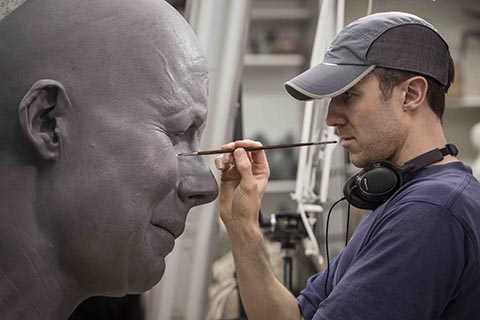Weta Workshop, Designers and Fabricators for The Lord of the Rings and Avatar, Reap the Benefits of Massivit 3D Large Format 3D Printing Technology
Press release from the issuing company
Company aims to overcome size, speed, and complex geometry limitations associated with traditional fabrication technology
Lod, Israel – Massivit 3D, the leading provider of large format 3D printing technology for visual communication and entertainment, has announced that Academy Award®-winning design studio and manufacturing facility, Weta Workshop, has installed a Massivit 1800 3D Printing Solution at its Wellington, New Zealand-based premises.
The company is recognized for its work on blockbuster films such as The Lord of the Rings and The Hobbit motion picture trilogies, Avatar, King Kong, Ghost in the Shell, and Blade Runner 2049. The installation of this Massivit 1800 was made possible by Massivit 3D’s local Australian and New Zealand distributor, Stick on Signs.
Richard Taylor, Weta Workshop Co-founder, CEO and Creative Director, says, “We manufacture super-sized, hyper-realistic human figures, creatures, vehicles, and other huge props for film and television and have always been on the search for technology that can produce large parts at a high speed.
“For 15 years, we have dreamed of a day when a printer would provide super large scale, speed, and build strength at low print costs, in equal measure. The Massivit 1800 has delivered this for us.”
Taylor adds, “With the Massivit 1800, our team has been able to redefine what is creatively possible for our large-scale manufacturing projects. It is a powerful and versatile machine that has transformed the way we work and has supercharged our output. It really is a dream come true.”
According to Pietro Marson, Workshop Operations Analyst at Weta Workshop, the company’s manufacturing teams have until now deployed a range of technologies for their fabrication processes, including CNC routers, industrial robots, and smaller 3D printers. Many of these technologies have presented limitations when it comes to manufacturing bigger props.
“We’re often required to create 8- or 9-meter-tall (26.2 or 29.5-foot) sculptures and mannequins, which means we need to print multiple parts and then manually fit them together,” he explains. “Needless to say, this is both time-consuming and expensive.
“The largest commercially available SLA 3D printer in the country has a maximum print volume of 60 x 60 x 40 centimeters, whereas the Massivit 1800 allows us to print up to 1.8-meter-high [5.9-foot] components,” he continues. “We can also print much more quickly and with far greater geometry freedom than with CNC machining.”
Weta Workshop expects to be able to save thousands of dollars by printing larger components. The Massivit 1800’s print volume has proven particularly useful for one of the company’s latest projects which requires the production of large-scale molds. Producing these molds with CNC technology would have been challenging due to their size and the inability of CNC routers to create complex, deep intrusions.
“The Massivit 1800 has surpassed our expectations insofar as the added capabilities and extra efficiency it delivers our operations,” says Richard Taylor. “Since its installation, it has stimulated a lot of creative thought and our teams are buzzing with what we will be able to achieve with it moving forward,” he concludes.

According to Weta Workshop, the Massivit 1800 3D Printer redefines what is creatively possible for large-scale manufacturing projects.
- Questions to ask about inkjet for corrugated packaging
- Can Chinese OEMs challenge Western manufacturers?
- The #1 Question When Selling Inkjet
- Integrator perspective on Konica Minolta printheads
- Surfing the Waves of Inkjet
- Kyocera Nixka talks inkjet integration trends
- B2B Customer Tours
- Keeping Inkjet Tickled Pink
© 2024 WhatTheyThink. All Rights Reserved.














